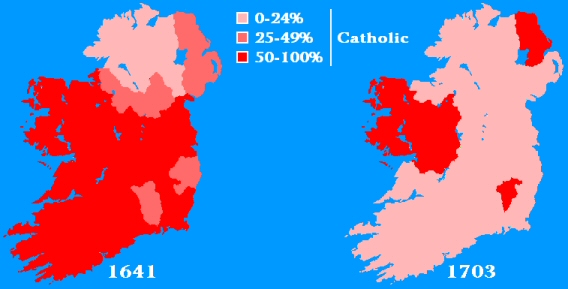
Plantations in 16th and 17th century Ireland involved the seizure of land owned by the native Irish and granting of it to colonists ("planters") from Britain. This process began under the reign of Henry VIII and continued under Elizabeth I, James I, Charles I, and Cromwell.
The early plantations of Ireland in the 16th century tended to be based on small "exemplary" colonies. The later plantations, such as those of Munster and Ulster, involved mass confiscations of land from rebel Irish landowners and the importation of large numbers of settlers from England, Scotland and Wales. The final official plantations took place under Oliver Cromwell’s English Commonwealth during the 1650's, when thousands of Parliamentarian soldiers were settled in Ireland. However, outside of the state sponsored plantations, significant migration into Ireland continued well into the 18th century, from both Britain and continental Europe.
|
The Irish Confederates had hoped for Royalist victory in the Wars of the Three Kingdoms (intertwined series of conflicts that took place in Scotland, Ireland, and England between 1639 and 1651), so that they could prove their loyalty to Charles I and force him into accepting their demands - including toleration for Catholicism, Irish self-government and an end to the Plantation policy. However, Charles’ Royalists were defeated in the English Civil War by the Parliamentarians under Oliver Cromwell, who committed himself to re-conquering Ireland and punishing those responsible for the massacres of 1641 when the Munster Plantation was destroyed. |
Decrease in Catholic land ownership
under Cromwell

The plantations substantially altered the demography of Ireland, creating large
communities of people who had a British and Protestant identity, in contrast to
the earlier Irish and Roman Catholic inhabitants (see map above). They also
affected the politics of the country, creating a British Protestant ruling class
and strengthening the control of the London government over Ireland. The
Plantations also substantially changed the physical and economic nature of Irish
society — opening up what had been a subsistence economy to intensive commercial
agriculture and trade. The Plantations also had a major cultural impact. Gaelic
Irish culture was sidelined and English replaced Irish as the language of power
and business. Finally, the plantations also radically altered Ireland’s ecology
and physical appearance. In 1600, most of Ireland was heavily wooded and covered
with bogs. Most of the population lived in small townlands, many migrating
seasonally to fresh pastures for their cattle. By 1700, Ireland’s native
woodland had been decimated, having been intensively exploited by the new
settlers for commercial ventures such as ship-building, and much of the bog land
was drained for agriculture.
credits:
1. The text was extracted from Wikipedia The Free Encyclopedia under GNU Free Documentation Licence.